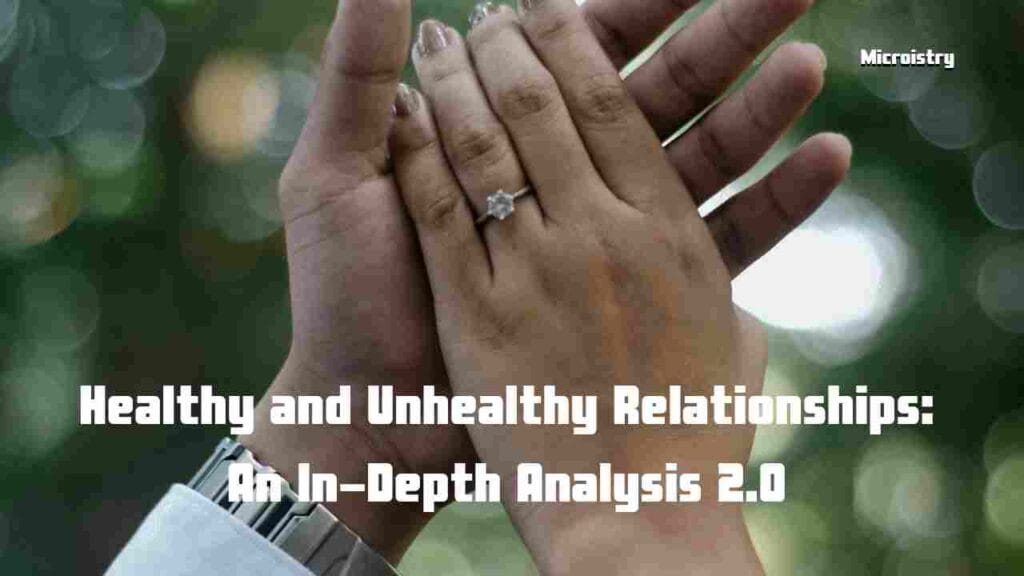Healthy and Unhealthy Relationships: Relationships are an integral part of our lives. Whether it’s the love of parents, the bond of friendship or the companionship of a life partner—relationships affect our emotional, mental and social well-being. But not every relationship is the same. Some relationships give us strength which we call healthy relationships while some hurt our soul which we call unhealthy relationships. In this blog we will explore in detail what healthy relationships are, how to identify unhealthy ones and how we can move towards building healthy relationships.

What are healthy relationships?
Healthy relationships are those that provide us with mental peace, confidence and emotional balance. These relationships are built on a foundation of mutual respect, trust and understanding.
Key characteristics of healthy relationships:
- Mutual Respect: Valuing each other’s thoughts, emotions and personal boundaries.
- Open Communication: Sharing your thoughts and feelings without fear or hesitation.
- Trust and Loyalty: Trusting each other and not cheating.
- Space and Freedom: Maintaining personal freedom even while being in a relationship.
- Support and Understanding: Supporting during difficult times and understanding each other’s needs.
- Absence of Toxic Behaviors: There is no room for insults, taunts or mental violence.
What are unhealthy relationships?
Unhealthy relationships are those that may lead to emotional, mental or even physical harm. They involve toxic behavior, imbalances and misuse of power.
Key signs of unhealthy relationships:
- Constant controlling nature: One partner always tries to control the other—over clothes, friends & career, etc.
- Jealousy and Insecurity: Unwarranted suspicion, intrusive behavior and excessive jealousy.
- Emotional or physical abuse: Yelling, insulting, pushing or hitting.
- Blame game: Blaming you for every mistake.
- Lack of Freedom: Not allowed to do anything according to one’s own will.
- Emotional Manipulation: Using phrases like “If you really loved me, you would do this” to control or guilt someone.
Difference Between Healthy and Unhealthy Relationships:

1. Trust:
- In a healthy relationship: Both partners trust one another without constant suspicion or secretive checking. Honesty and understanding form the foundation of that trust.
- In an Unhealthy Relationship: Walls of doubt are built. There is suspicion in every matter, which weakens the relationship. Keeping an eye on each other’s activities becomes normal.
2. Communication:
- In a healthy relationship, both partners openly share their thoughts and feelings while also actively listening to one another. Conversations are respectful and thoughtful, whether the issue is small or big.
- In an Unhealthy Relationship: Communication is avoided or happens in anger. Things are often hidden or the other person’s point of view is ignored, leading to misunderstandings and distance.
3. Respect:
- In a healthy relationship, both partners respect each other’s emotions, thoughts, decisions and boundaries. Neither person tries to belittle or undermine the other.
- In an Unhealthy Relationship: Disrespect, taunts, sarcasm or mental pressure become common. One person always considers themselves superior and the other inferior.
4. Support:
- In a Healthy Relationship: Support is given even in difficult times. Partners help each other in achieving life goals and dreams.
- In an Unhealthy Relationship: There is often criticism, discouraging words are spoken and instead of moving forward, one is held back.
5. Independence:
- In a Healthy Relationship: Both have the freedom to live with their own identity and likes-dislikes. A person can make their own decisions.
- In an Unhealthy Relationship: One partner wants to control everything about the other – what to wear, who to talk to and what to do – commanding becomes common.
6. Boundaries and Space:
- In a Healthy Relationship: Personal boundaries are respected. Giving space strengthens the relationship.
- In an Unhealthy Relationship: Boundaries are not valued. Interfering in everything and expecting to be together all the time becomes necessary, leading to a feeling of suffocation.
7. Conflict Resolution:
- In a Healthy Relationship: When a conflict arises, it is resolved peacefully and with mutual understanding. No argument leads to breaking the relationship.
- In an Unhealthy Relationship: Arguments can be aggressive, insulting or violent. Instead of solving the problem, blame is assigned.
What to Do If You’re in an Unhealthy Relationship?

1. Recognize and accept that this relationship is harmful to your wellbeing
The very first and most important step is to understand that you are in a relationship that is harming your mental, emotional or physical health. Sometimes we get so entangled in a relationship that we start accepting the pain as normal. Ask yourself honestly—does this relationship make me happy or break me? If the answer is negative then recognizing and accepting it will be the first big and brave step.
2. Talk to someone you trust, like a friend, family or a counselor
When you are in an unhealthy relationship, loneliness and fear can influence your decisions. In such situations talk to someone you trust—someone who will listen to you without judgment. Seeking professional help (like a counselor or therapist) is also a very good option, as they can help you think clearly and make the right decisions.
3. Set boundaries and stick to them
An unhealthy relationship often disregards your boundaries—be it your time, emotions, or personal space. It’s important to define what is acceptable to you and stand by it. Clearly share these boundaries with the other person and follow them firmly. Remember your boundaries are your protection.
4. If necessary, maintain distance or break the relationship
If your boundaries are being repeatedly violated or you are facing mental, emotional or physical harm then it becomes necessary to distance yourself from that relationship—even if it means ending it completely. It will be difficult but sometimes protecting yourself is the most important thing.
5. Move on to healthier relationships—love yourself & maintain self-esteem
After coming out of an unhealthy relationship, the healing process begins. Reconnect with yourself and rebuild your self-esteem. Surround yourself with people who respect you, appreciate you and understand your emotions. Most importantly, learn to love yourself—because a strong sense of self-worth will help you choose healthy relationships in the future.
Always remember: You are worthy of a relationship that is happy, respectful and safe. If any relationship is taking away your self-respect, peace and happiness then walking away from it is your strength, not your weakness.
Ways to build healthy relationships:
- Boost your self-esteem and understand yourself.
- Maintain transparent and positive communication.
- Learn to forgive but don’t tolerate repeated hurt.
- Encourage each other and support growth together.
Conclusion:
Relationships can make life beautiful and sometimes difficult too. But the most important thing is to recognize which relationships are beneficial for you and which are harmful. Healthy relationships not only improve your life but also strengthen your mental and emotional well-being. On the other hand, unhealthy relationships can slowly drain your energy and self-confidence.
You have the right to choose relationships that support you, not break you. THANKS